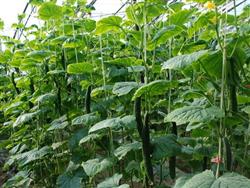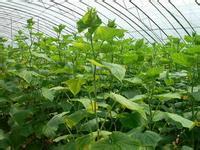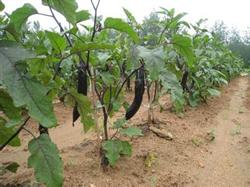The "five reforms" has high efficiency in planting overwintering cucumbers.

The thick planting seedlings were changed into reasonable sparse planting. In winter, the temperature is low, the light is weak, the crop photosynthesis is poor, reasonable sparse planting can achieve high yield. If the plant is too dense, it will grow upward because of winning honor, and the melon setting rate will decrease. Poor ventilation is easy to be infected with a variety of diseases, and the leaves are thick and difficult to administer medicine, once the disease spreads, it is difficult to cure completely. Flat border planting was changed to furrow planting or ridge planting. Trench planting is to dig ditches on flat land and plant seedlings on both sides of the ditch, with a general ditch depth of 30-35 cm. Ridge planting is ridge cultivation, the seedlings will be planted on both sides of the ridge, the general ridge height of 20-25 cm. When planted in ridge or furrow, the visible surface is large, which is conducive to the improvement of soil temperature; the air permeability of rhizosphere soil is good, which is conducive to rooting, which can greatly enhance the disease resistance and stress resistance of plants and the ability of continuous melon bearing; it is easy to control fertilizer and water, so as to avoid water damage, hypertrophy and root burning. After slow seedling, root irrigation to prevent disease was changed to apply medicine to control disease when planting. In view of the serious soil-borne diseases, especially the serious mildew root rot of grafted cucumber, many vegetable farmers adopt the method of planting slow seedlings and filling roots to prevent the disease. Although the method has a certain effect, it is labor-consuming and time-consuming and the efficacy is short. Therefore, it can be changed to the method of applying medicine at the acupoint to prevent the disease. The planting in cloudy days was changed to sunny days. Planting in cloudy days, weak light and high humidity in the greenhouse is not conducive to rooting; planting in sunny days, although the seedlings are easy to wilt after planting, it is conducive to rooting and slow seedling. In addition, when planting, the seedlings should be graded according to large, medium and small, and transported to the planting ditch or ridge. From the point of view of the whole shed, the big seedlings should be put on the east and west ends and the front of the shed, and the small seedlings should be put in the middle of the shed. From a line point of view, big seedlings in front, small seedlings in the back, generally seedling in the middle, which is conducive to the later growth of the plant neatly consistent. Fertilization is often changed to scientific fertilization. The high yield of cucumber is inseparable from fertilization, but it is not that the more fertilizer is applied, the higher the yield. The key is what fertilizer to apply and how to apply it. The amount of fertilizer can not only be determined by the number of kilograms, but also depends on the composition and content of the fertilizer. If you don't have a lot of fertilizer, you have to go the right way. It is necessary to apply fertilizer scientifically, not blindly based on perceptual experience. Only according to the characteristics of fertilizer demand of cucumber and the specific conditions of fertilizer supply in each greenhouse, selecting high quality fertilizer scientifically and reasonably and applying fertilizer in a balanced and all-round way can the high quality and high yield of cucumber be realized.
- Prev

Technical specification for pollution-free cultivation of cucumber in greenhouse
1. Soil selection and tillage 1. Soil selection: choose fields where the previous crops are not melons because of fertile soil and convenient transportation. 2. Ploughing, tanning and disinfection: the cultivated land dissolves and ploughs the field one month before planting, and then prepares the soil after drying. 3. Bed adjustment: 3-5 days before planting.
- Next

Topdressing methods of eggplant in summer
Open ditches and fertilize. It has become a habit for vegetable farmers to apply chemical fertilizer with water, but this method should not be used in summer high temperature season. Because of the high temperature, the effect will be reduced after a large amount of ammonia volatilization in the application of chemical fertilizer. In particular, ammonium bicarbonate is more likely to cause ammonia poisoning in eggplant. The effect of trenching or burying holes is adopted.
Related
- Where is it suitable to grow horseradish in China? it is expected to see the middle altitude horseradish in Alishan.
- How to prevent tomato virus disease reasonably? (Control methods included)
- Many people like to plant towel gourd on the balcony. What are the main points of this method and management?
- What crops can chili peppers be mixed with?
- Fertilization techniques and matters needing attention in Tomato
- What are the grafting techniques for peach seedlings in spring?
- Harm and control methods of root swelling disease of Chinese cabbage
- What are the pests of sweet potatoes? How to prevent and cure it?
- Symptoms, causes and Control methods of navel Rot in Tomato
- The cause of "Cucumber rotten bibcock" in Farmers' planting Cucumber and its Control Plan

